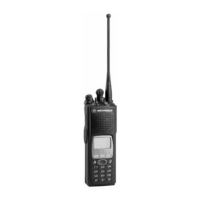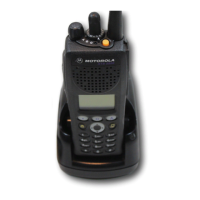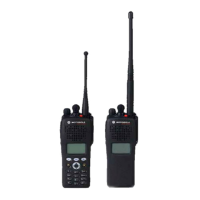6881094C31-E November 16, 2006
Theory of Operation: VOCON Board 3-25
The VSW2 regulator is a SPI programmable switching regulator that uses VSW1 as its input on pin
PSRC2. The initial output of VSW2 (R501) is 2.2 volts, which is then programmed to 1.875 volts
(referred to as 1.8 volts throughout this document). The VSW2 voltage is supplied to the Patriot IC
(core voltage and the EIM voltage), the SRAM U403, the Flash memory U402, and the display
module connector J301 (1.8 V display interface only for the NTN9564 VOCON kit).
The V2 regulator is a SPI programmable linear regulator that uses VSW1 as its input on pin VIN2.
The initial output of V2 (R560) is 2.775 volts, which is then programmed to 3 volts for the NTN9564,
NNTN4563, and NNTN4819 VOCON boards, and 2.9 volts for the NNTN4717 VOCON board. The
V2 voltage is supplied to the Patriot IC (I/O ring - SPI, BBP, SAP, UART, GPIO, etc.), the Flipper IC
U301, the EEPOT U509, the display module connector J301, and the many discrete components
that interface with the Patriot IC and the Flipper IC.
3.2.3.1.2 MCU Interface
The GCAP II IC has a four-wire, SPI connection to the Patriot IC (SPI B). The SPI B clock is
connected to the SPI_CLK pin (test point SCKB). The SPI B MOSI line is connected to the SPI_DW
pin (test point MOSIB). The SPI B MISO line is connected to the SPI_DR pin (test point MISOB). The
GCAP SPI B chip-select signal is connected to the CE pin (R539). Through this interface, the Patriot
IC can program the voltage regulators, the CODEC, the transmit and receive audio filters and
amplifiers, as well as read information from the ADC and the real-time clock.
The GCAP II IC has an 8-bit ADC with general-purpose six channels and four voltage-monitoring
channels. The six general-purpose analog-to-digital (A/D) channels are assigned to monitor volume
(AD5); the three-position toggle switch from the universal connector J101 (AD1); the emergency,
monitor, and side buttons (AD0); the battery status line (AD2); the board type indicator (AD3); and
the board identification voltage (AD4). Battery voltage is also monitored by the ADC. The Patriot IC
activates and reads the A/D values through the SPI bus.
The real-time clock (RTC) module of the GCAP II IC consists of several counters to determine
elapsed time. The Patriot IC reads the RTC registers through the SPI bus. The RTC is supplied with
voltage from a backup lithium rechargeable battery (LI_CELL) and a 32.768 kHz clock signal from
the Flipper IC to the GCAP II IC XTAL1 pin.
3.2.3.1.3 Audio Circuitry
A 13-bit CODEC, internal to the GCAP II IC and programmable by the Patriot IC through the SPI bus,
converts microphone audio into a digital bit stream for processing by the DSP. The CODEC also
converts receive audio data that was processed by the DSP into an analog audio signal for
amplification to a speaker. The CODEC interfaces to the DSP through the 4-wire SAP bus. The
CODEC clock, which is 520 kHz (for the NTN9564, NNTN4563, and NNTN4819 VOCON boards) or
256 kHz (for the NNTN4717 VOCON board) is supplied to the DCLK pin. The CODEC 8 kHz
CODEC frame synchronization signal is supplied to the FSYNC pin. The CODEC transmit data
signal is on the TX pin, while the CODEC receive data signal is on the RX pin. For the CODEC to
operate with those clock and frame sync signals, a 13 MHz clock (R302), generated by the Flipper
IC, is supplied to the GCAP CLK_IN pin.
The GCAP II IC contains internal amplification, filtering, and multiplexing functionality for both
receive and transmit audio. These functions are Patriot IC-programmable through the SPI bus. The
input for the internal microphone audio (R540) is the MICIN_NEG pin, while the input for the external
microphone audio (R566) is the AUX_MIC_NEG pin. The output for the speaker audio is the
EXTOUT pin (C533).

